The sparkling-white Myoko Highlands of Japan, called Myokokogen (妙高高原), richly deserve the same worldwide acclaim that the snowshoeing meccas of Banff, Alberta; Yosemite, California; and Leysin, Switzerland have garnered. This year, Myoko will host the 16th All Japan Mountain Snowshoeing Race, which was held on Feb. 15 and 16.
Myoko, though, is not only for competitive racers and experienced climbers of winter peaks: for those snowshoers who like to pause to suck on icicles, draw angels in snow, catch snowflakes with their tongues, or watch wildlife there are plenty of move-at-your-own-pace snowshoe experiences to be enjoyed. Add to that, Myoko’s volcanic environment is the source of five types of hot spring water, perfect for après-snowshoe relaxation.
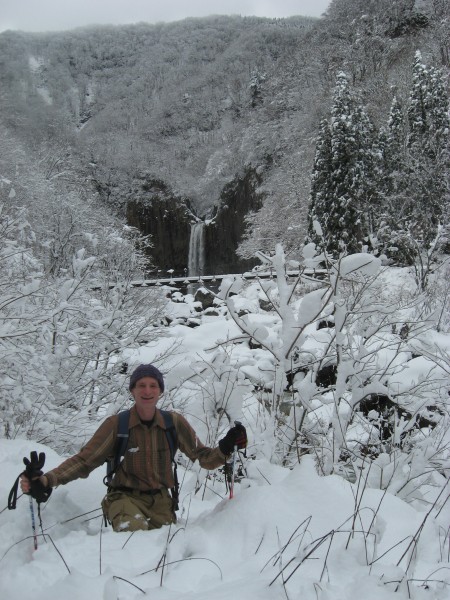 Exactly what is Myoko? Myoko is the name of a city, as well as a 2,454 meter-high (8,051 feet) mountain that the Japanese government lists as one of Japan’s 10 most beautiful mountains. The Myoko Highlands are part of Niigata Prefecture, almost on the border of Nagano Prefecture. The 1998 Winter Olympics were held just a short drive away in Nagano. The snow, the views, and the accommodations in both prefectures are exceptional. However, Nagano got the Olympic fame and the money. Myoko didn’t, but the natural conditions are just as fantastic.
Exactly what is Myoko? Myoko is the name of a city, as well as a 2,454 meter-high (8,051 feet) mountain that the Japanese government lists as one of Japan’s 10 most beautiful mountains. The Myoko Highlands are part of Niigata Prefecture, almost on the border of Nagano Prefecture. The 1998 Winter Olympics were held just a short drive away in Nagano. The snow, the views, and the accommodations in both prefectures are exceptional. However, Nagano got the Olympic fame and the money. Myoko didn’t, but the natural conditions are just as fantastic.
During one of the most satisfying weekends of my snowshoeing life, I walked on Myoko’s snowy mountain routes, dipped in hot springs with winter views, gained insights into Japanese culture, climbed to a gorgeous waterfall, and pigged out on excessively delicious Japanese food. On top of that, I also heard, saw, and photographed an avalanche.
At the time of the avalanche, my wife and I were snowshoeing on a knoll above the minuscule village of Tsubame (燕), which means sparrow. The village of approximately twenty buildings is perched, like a sparrow’s nest, on a steep cliff at an elevation of 1,190 meters (3,904 feet). We had paused to watch the movements of a river cascading over and slicing between home-sized boulders just below us. The river was in a steep valley between two mountains. The one that we were on sloped gently, but the other was a picturesque towering peak. We suddenly heard an echoing “whumph,” which morphed into the roar of a large jet, combined with the sounds of massive rocks crushing together.
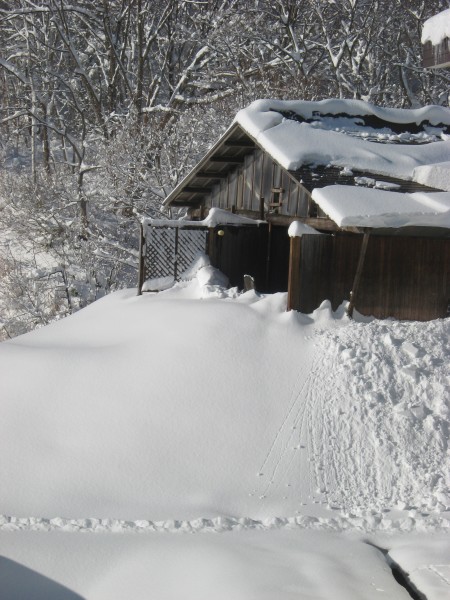 Our heads jerked upwards and we saw on the other mountain that a field of snow was sliding, jumping over crags, and swirling between clumps of trees with the speed of a professional skier empowered with the force of thousands of monster tractors. It was all over in a few seconds, but anyone underneath that torrent of snow would have been crushed or suffocated. The avalanche was a reminder of the unpredictable deadly forces that are usually dormant within those beautiful mountains. I managed to take a few photographs that remind me when I look at them of the awesome, destructive power of avalanches. Carrying a sense of awe within us, we continued trekking and relishing mountain vistas, while staying on the safer slopes.
Our heads jerked upwards and we saw on the other mountain that a field of snow was sliding, jumping over crags, and swirling between clumps of trees with the speed of a professional skier empowered with the force of thousands of monster tractors. It was all over in a few seconds, but anyone underneath that torrent of snow would have been crushed or suffocated. The avalanche was a reminder of the unpredictable deadly forces that are usually dormant within those beautiful mountains. I managed to take a few photographs that remind me when I look at them of the awesome, destructive power of avalanches. Carrying a sense of awe within us, we continued trekking and relishing mountain vistas, while staying on the safer slopes.
We had gone to Tsubame to snowshoe and to soak in its fabled outdoor springs that are free for any visitor willing to hike to them. Tsubame Onsen is famous among the Japanese hot spring cognoscenti who seek outdoor hot springs in forests. Sadly, we had arrived just half an hour after the hot springs were closed for winter. They are closed because of the danger caused by excessive snow, and, due to so much snow, maintenance becomes impossible.
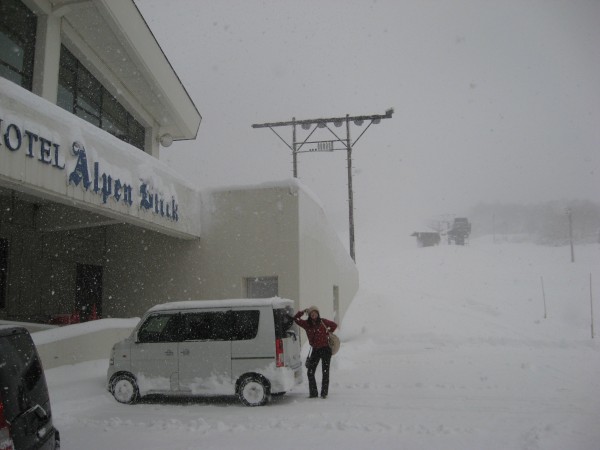 Our hardworking muscles deserved a hot spring after the walk in the snow. So we followed the recommendation of an elderly man shoveling snow (we only met senior citizens living in the village), and sought out Hotel Iwadoya (岩戸屋). This hotel, like many old hotels in the Japanese mountains, was furnished like a museum of local culture. Inside, you can see stuffed ferrets and other animals, Buddhist artifacts, irori (an open hearth used for cooking and heating) and other objects representative of past eras. The kindly proprietor requested that I wait a short while for an earlier group of visitors to finish bathing, and she offered free cups of aromatic tea made from roasted green tea leaves. Sipping the tea, I strolled through the old ryokan (Japanese inn) and savored the decor.
Our hardworking muscles deserved a hot spring after the walk in the snow. So we followed the recommendation of an elderly man shoveling snow (we only met senior citizens living in the village), and sought out Hotel Iwadoya (岩戸屋). This hotel, like many old hotels in the Japanese mountains, was furnished like a museum of local culture. Inside, you can see stuffed ferrets and other animals, Buddhist artifacts, irori (an open hearth used for cooking and heating) and other objects representative of past eras. The kindly proprietor requested that I wait a short while for an earlier group of visitors to finish bathing, and she offered free cups of aromatic tea made from roasted green tea leaves. Sipping the tea, I strolled through the old ryokan (Japanese inn) and savored the decor.
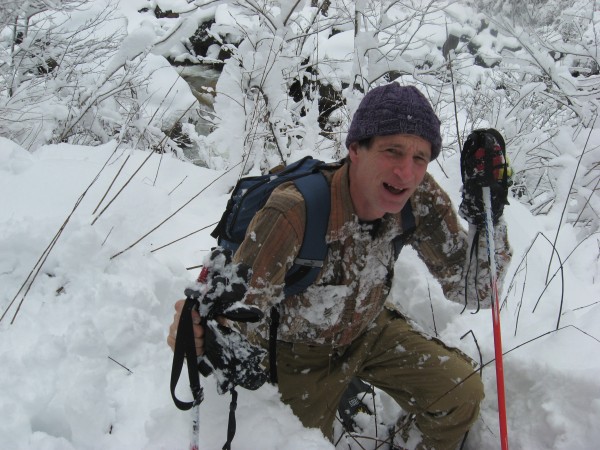 When I went into the bathing area, I found two baths: a hot and steamy indoor bath and a rustic outdoor one surrounded by snow banks. The small outdoor bath close to the edge of the mountain had a view of blue sky and a white mountain across a deep valley. The smell of sulfur was strong, and the water was thick with natural mineral substances. Hot running water poured from a bamboo tube onto my back. My senses were stimulated while my body relaxed. All in all, it was another great foray into a new Japanese hot spring and more exposure to Japanese culture within a remote village. In the future, I may stay at that hotel or in that village.
When I went into the bathing area, I found two baths: a hot and steamy indoor bath and a rustic outdoor one surrounded by snow banks. The small outdoor bath close to the edge of the mountain had a view of blue sky and a white mountain across a deep valley. The smell of sulfur was strong, and the water was thick with natural mineral substances. Hot running water poured from a bamboo tube onto my back. My senses were stimulated while my body relaxed. All in all, it was another great foray into a new Japanese hot spring and more exposure to Japanese culture within a remote village. In the future, I may stay at that hotel or in that village.
That weekend, though, we were satisfied with Hotel Alpenblick, the hotel that became our base for that weekend. Resting on the edge of forests within the Ikenotaira Onsen Ski Resort area of Mt. Myoko, plenty of snowshoeing opportunities are just out the front door. Snowshoeing trails circle the nearby Myoko Kogen Visitor Center, which has educational displays of the local ecology. I learned that Myoko is the home of two species of nocturnal flying squirrels, and that night snowshoeing tours of the area around the nature center are available. However, we already had a full schedule planned, and we could not fit a night tour into that trip. One is scheduled for my next visit to Myoko.
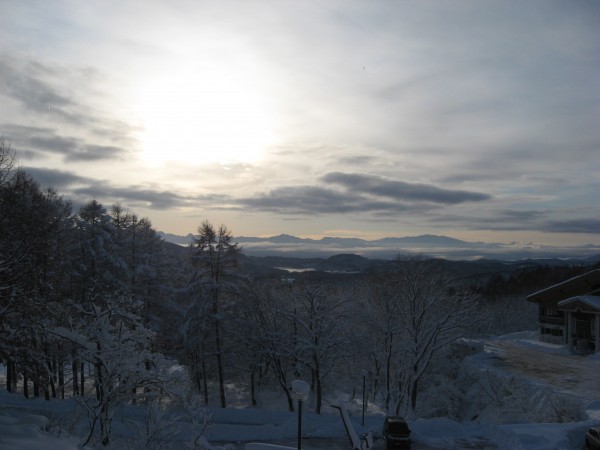 The evening before going to the visitor center, we had arrived at the Alpenblick Hotel after the neighboring ski resort had closed, which was perfect timing to snowshoe on the empty grounds. We walked through the woods next to the groomed runs. Soft snowflakes had been falling continuously all day, so we sank to our thighs in the powder. No one else was around. The sky cleared and brilliant stars blinked at us through heavily laden tree branches. Somewhere near by us, owls hooted while my wife making a snow angel.
The evening before going to the visitor center, we had arrived at the Alpenblick Hotel after the neighboring ski resort had closed, which was perfect timing to snowshoe on the empty grounds. We walked through the woods next to the groomed runs. Soft snowflakes had been falling continuously all day, so we sank to our thighs in the powder. No one else was around. The sky cleared and brilliant stars blinked at us through heavily laden tree branches. Somewhere near by us, owls hooted while my wife making a snow angel.
After making angels, we went back to the hotel for a hot spring before dinner. First, in our room, we changed into the thin Japanese robes, or yukata, provided for guests and walked through a hallway to the outside hot spring. Walking in the unheated hallway with just a thin robe was like jumping through the ice on a frozen lake, but the thermal water rescued me. Air from my breath and steam swirled off the surface of the bath into the air like a dancing miasma. Thoroughly refreshed, we headed to the restaurant to gluttonously ravage steamed crab, sushi, sashimi, noodles, locally-made tofu, and other dishes were included in the dinner buffet. Surprisingly, German-style dark beer is brewed and served on the premises.
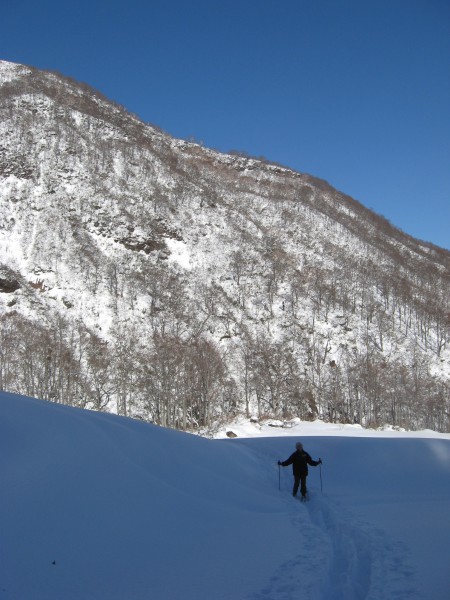 I rose early to catch the sunrise from the hot spring. One other person was already in the bath looking at the morning view. The sunlight and steam silhouetted his body, creating a mysterious aura around him. I stepped into the bath, and, in the light of the morning, I noticed that the spring water was black, a rare color for a hot spring. The hot water was drawing up many dark minerals as it flowed out of the earth. The spring is unfiltered and unsullied with chlorine.
I rose early to catch the sunrise from the hot spring. One other person was already in the bath looking at the morning view. The sunlight and steam silhouetted his body, creating a mysterious aura around him. I stepped into the bath, and, in the light of the morning, I noticed that the spring water was black, a rare color for a hot spring. The hot water was drawing up many dark minerals as it flowed out of the earth. The spring is unfiltered and unsullied with chlorine.
After our morning bath and breakfast, we walked on snowshoes to a waterfall that I had been inspired to visit because of gorgeous photographs. Naena Falls, or Naenanotaki in Japanese, is 55 meters (around 60 yards) high and is listed as one of Japan’s best waterfalls by the government. The Japanese government has various lists of the most 100 attractive natural features of the country.
Mountain roads leading to the walking trail to the waterfall were unplowed, so we had to snowshoe in, which was fine with me. Walking between strands of tall snow-frosted cedars, we reached the end of the road and found the hiking path. I smelled sulfur in the cold mountain air and soon discovered a small channel of hot spring water flowing from a hole in the ground. We followed the trail past a small dam and along the side of a river. The waterfall appeared tiny from a distance in the middle of a valley where all of the trees were tufted with white clouds of snow. A small suspension bridge heavy with snow was below the waterfall. As we came closer, we could sense the power of the water flowing over its top. The sound was like rolling thunder.
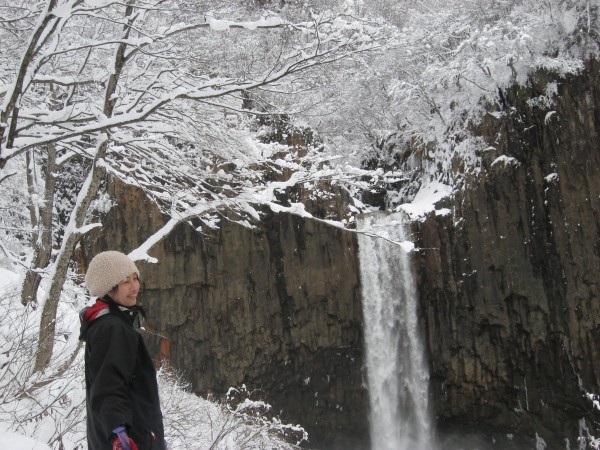 My wife wanted to get high enough to look down upon the waterfall, so we climbed a slope to the left of the waterfall. We repeatedly slipped backwards in the soft slippery snow, but finally reached our goal; the view was spectacular. It was first time to be so close to a waterfall in such cold temperatures. That trip to the waterfall and all our other experiences in Myoko are still frozen in my memory. And there are so many more winter adventures remaining for us to experience on our next trips to Myoko.
My wife wanted to get high enough to look down upon the waterfall, so we climbed a slope to the left of the waterfall. We repeatedly slipped backwards in the soft slippery snow, but finally reached our goal; the view was spectacular. It was first time to be so close to a waterfall in such cold temperatures. That trip to the waterfall and all our other experiences in Myoko are still frozen in my memory. And there are so many more winter adventures remaining for us to experience on our next trips to Myoko.






Can you recommend a fine touring company for snowshoeing in Japan?
My fantasy is to x-c ski from ryokan to ryokan … you are getting the result I expected. Thanks
Looks like snowshoe haven. Interesting name for the hotel in Japan.